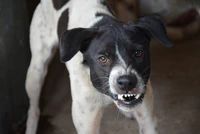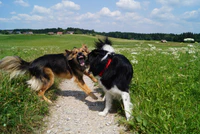Listen to the Blog-Cast:
The Challenges of Winter for Dogs
Winter brings its own set of unique challenges for our four-legged friends. As the days grow shorter and temperatures drop with plenty of rain and wind here in Ireland the routines that keep dogs physically active and mentally engaged often shift, leading to potential stress and discomfort. It’s essential for dog owners to adjust their care routines to ensure their pets remain healthy and happy during these months.
One major challenge is the disruption to normal routines. Dogs are highly sensitive to changes in their daily activities, and winter can often force owners to alter schedules or reduce time spent outdoors. Not only do I not want to go for a walk in the wind and rain… but neither does my dog! This shift can lead to boredom and frustration, because walks offer our dogs more than just exercise. If we don’t meet those other needs, we run the risk of creating behavioural issues as dogs miss out on the exploration and stimulation they typically enjoy during warmer months (I am also a fair-weather lady!). For active breeds or younger dogs, this change can be particularly unsettling, increasing the need for creative indoor solutions to burn off energy.
Temperature regulation is another significant consideration when we do venture outside. While some breeds are naturally equipped to handle cold weather, others particularly smaller breeds, puppies, and senior dogs may struggle to stay warm. Exposure to colder temperatures can pose health risks such as hypothermia if dogs are left outside for extended periods without proper protection (outdoor dogs should come indoors during winter). Frost or frozen paths can hurt the pads of dogs’ feet, especially if a lot of salt has been put down to de-ice roads and pavements. Even a simple walk in the snow can pose risks, as snow and ice build-up between paw pads can cause discomfort and lead to cracks or injuries if left unchecked. Older dogs or those with arthritis will feel the cold much more, and walks in the cold air may not be the best way to support their needs, as the cold can exacerbate joint pain.
Social interactions can also be affected during the winter months. With fewer opportunities for outdoor playdates or visits to the park, dogs may experience reduced socialisation with other dogs, leaving some who enjoy canine company feeling isolated or frustrated. Dogs thrive on interaction though they all have their own preferences, whether with their human companions or other dogs and the quieter winter months can sometimes leave them feeling a bit lonely.
Oh goodness… lots of winter hazards… to say the least! Don’t worry, this blog has you covered!
Fun Indoor Activities to Keep Your Dog Moving
When winter weather makes outdoor adventures less appealing, it’s time to get creative with indoor activities that keep your dog both physically active and mentally engaged. Dogs thrive on movement and stimulation, and with a little imagination, you can transform your home into one that meets their exercise needs while enjoying time together.
Interactive Games to Burn Energy
Indoor play doesn’t have to mean missing out on fun.
Classic games like tug-of-war provide an excellent outlet for your dog’s energy. Be sure to set clear rules, such as teaching them to release the toy when asked, then giving it back to reward good play etiquette keeping the game safe and enjoyable.
Hide-and-seek is another fantastic option. One person can hide in another room while the dog is encouraged to “find” them, offering an exciting mental and physical challenge. We love this game in our house ‘find David’ (who is often behind a door or curtain) is utter fun, and our Izzy loves it!
Fetch indoors works too! A hallway is often perfect. Just make sure you have a rug or non-slip surface down, as slippery floors (like laminate wood) can cause injuries.
Food-Motivated Fun
Harness your dog’s natural foraging instincts by incorporating food into play.
Puzzle toys and treat dispensers are excellent tools, offering hours of entertainment while stimulating problem-solving skills. While there are many you can buy online, you can also make DIY versions. Check out my enrichment blog for ideas Enrichement Blog
Scatter feeding is another easy way to keep your dog engaged. Sprinkle their kibble (mixed with treats) around a room or in a safe area and let them sniff it out. You can also create “find it” games by hiding treats in various locations around your home, encouraging your dog to use their nose.
Training and Tricks for Mental Engagement
Winter is a perfect time to brush up on skills or teach new tricks.
- Try mastering “place” training, where your dog learns to settle on a designated mat.
- Explore clicker training techniques for more advanced behaviours.
- Teach fun tricks like “spin” or “high five” to add variety and excitement.
DIY Obstacle Courses for Agility and Fun
Bring agility indoors with a creative obstacle setup using household items.
- Use cushions as hurdles, create tunnels with blankets and chairs, or stack pillows for your dog to climb. Tailor the course to your dog’s size and skill level, and guide them through with treats or toys. Not only does this provide a great workout, but it also strengthens your bond as you work together.
Indoor activities can be just as fulfilling as outdoor play when approached with intention and care. By offering a mix of physical exercise and mental challenges, you’ll keep your dog entertained, healthy, and happy, regardless of the weather outside.
Ensuring Safe and Enjoyable Winter Walks for Your Dog
While winter can make outdoor adventures more challenging, daily walks remain an essential part of your dog’s routine. Fresh air, exercise, and exploration are important for both physical health and mental well-being. With a few precautions, you can ensure your winter walks are safe, comfortable, and enjoyable for both you and your pup.
Not all dogs are naturally equipped to handle the cold. Breeds with short coats, puppies, and senior dogs may benefit from a well-fitting coat or jumper for added warmth. Protect their sensitive paws with dog boots to shield them from ice, snow, and harmful de-icing agents like rock salt. If boots aren’t an option, applying a paw balm can help prevent cracking and dryness.
With shorter days, many winter walks happen in the early mornings or evenings when visibility is reduced. Equip your dog with reflective gear a high-visibility leash, harness, or collar and consider adding a small LED light to their collar. This improves visibility and ensures your dog is seen by drivers and pedestrians.
Safety Stride: HiVis & Reflectives
Keep walks shorter 15–20 minutes in daylight is often enough to support your dog. We often walk at night during winter, but dogs also need exposure to natural light (just like us). So even if you can only manage 15–20 minutes in daylight, that’s perfect.
You can also use enrichment scatter feeding in the back garden or another safe outdoor space instead of a walk. It gets their nose to the ground and engaged in an outdoor activity.
Dog-Friendly Festive Tips for Christmas
Christmas brings excitement, gatherings, and a host of new sights and smells for dogs, but it can also introduce stress and hazards. Ensuring your home and celebrations are dog-friendly is key to creating a safe and enjoyable environment.
Festive decorations can be intriguing for curious dogs but also potentially dangerous. Keep fragile ornaments, tinsel, and electrical cords out of reach. Avoid using toxic plants such as poinsettias, mistletoe, and holly, as these can be harmful if ingested.
Many Christmas treats and meals contain ingredients unsafe for dogs. Chocolate, raisins, grapes, fatty leftovers, and turkey bones can all cause serious health issues. Instead, include your dog with pet-safe treats or a small portion of plain, cooked meat with enrichment. Keep food out of reach and remind guests not to sneak your dog harmful snacks. And please don’t hang chocolate on your Christmas tree.
With visitors and increased activity, the festive season can be overwhelming. Set up a “safe zone” in a quiet area of your home where your dog can retreat. Endless visitors may not be fun for some dogs they’d rather chill! Equip this safe space with familiar bedding, toys, and calming aids like a pheromone diffuser or white noise. Associate it with positive experiences by giving enrichment there, so your dog sees it as their sanctuary.
If you’re hosting guests, communicate your dog’s needs and boundaries. Encourage visitors to greet your dog calmly and respect their space. If your dog becomes excitable or nervous around new people, use treats and cues to redirect them.
And a quick word on Christmas clothes: most humans love them, most dogs don’t. Please don’t force your dog to dress up. A festive bandana or collar is usually plenty. If your dog is comfortable wearing clothing, a jumper for family photos is fine but respect their comfort level.
Despite the busy season, try to stick to your dog’s regular routine for meals, walks, and playtime. Predictability helps reduce anxiety and ensures your dog feels secure amidst the Christmas excitement. If your plans include travelling, make sure your dog is comfortable with the journey or care arrangements. Whether boarding them or bringing them along, prioritise their safety and comfort.
Wrapping Up (Pun intended): A Season of Joy for Your Four-Legged Friend
For many people, Christmas is a time to celebrate, reflect, and spend time with loved ones including our dogs. Just remember, Christmas and winter look very different from a dog’s perspective; they don’t understand why it’s a “special day” for us.
This Christmas, if it’s important for your dog to be part of the day, try to see it from their point of view and make adjustments to support them.




